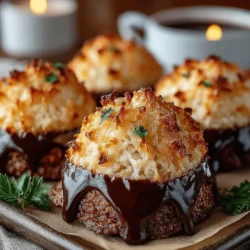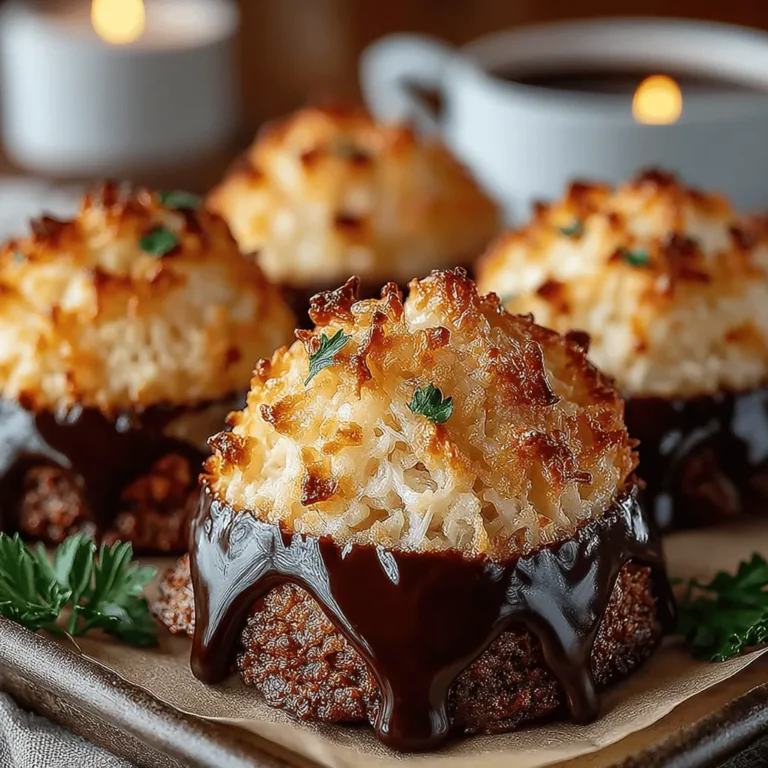Title: Decadent Chocolate-Dipped Coconut Macaroons: A Deliciously Sweet Treat
Introduction
Indulge in the rich, tropical flavors of Decadent Chocolate-Dipped Coconut Macaroons. These delightful bites combine the chewy texture of sweetened shredded coconut with a smooth chocolate coating, making them the perfect treat for any occasion. Whether you’re hosting a gathering, celebrating a milestone, or simply craving a sweet snack, this recipe is bound to impress family and friends alike. The combination of coconut and chocolate creates a symphony of flavors that transports you to a sun-kissed paradise with every bite.
In this article, we will explore the ingredients that make up these luscious treats, including sweetened shredded coconut, sweetened condensed milk, egg whites, and chocolate. We will also walk you through the initial steps of the recipe, ensuring you have all the information you need to create these delectable macaroons at home.
Understanding the Ingredients
To make the best chocolate-dipped coconut macaroons, it’s essential to understand the key components that contribute to their unique flavor and texture.
Coconut
Coconut is undoubtedly the star ingredient in this recipe. Sweetened shredded coconut provides a chewy texture and a natural sweetness that complements the chocolate coating perfectly. The use of sweetened coconut rather than unsweetened is critical, as it not only adds flavor but also helps bind the ingredients together, creating a deliciously moist macaroon.
When selecting coconut for your macaroons, you may come across both fresh and dried varieties. Fresh coconut can be a delightful addition to many recipes, but for macaroons, dried sweetened shredded coconut is preferred for its convenience and longer shelf life. The dried version is also easier to work with, as it maintains its structure during baking, resulting in the perfect balance of chewiness and crispiness.
Sweetened Condensed Milk
Sweetened condensed milk is another crucial ingredient in this recipe. This thick, creamy milk is concentrated and sweetened, which not only enhances the flavor of the macaroons but also serves as a binding agent. When mixed with coconut, it provides the necessary moisture to keep the macaroons soft and chewy, while also allowing for a slight caramelization during baking that adds depth to their flavor.
If you have dietary restrictions or are looking for alternatives, there are several substitutes for sweetened condensed milk. Vegan options are available, often made from coconut milk or almond milk, and can be found in many grocery stores. Alternatively, you can make your own sweetened condensed milk at home using plant-based milk and a sweetener of your choice.
Egg Whites
Egg whites play a vital role in achieving the perfect texture for coconut macaroons. Beating the egg whites until they reach stiff peaks is essential for providing structure and stability to the macaroons. When whipped, egg whites incorporate air, which helps the macaroons rise slightly during baking, resulting in a light and airy texture that contrasts beautifully with the chewiness of the coconut.
The science behind achieving stiff peaks lies in the process of aeration. As you beat the egg whites, the proteins unfold and create a network that traps air bubbles. This process is crucial, as under-beaten egg whites will not provide the necessary lift, while over-beaten egg whites can become dry and grainy. The key is to stop whisking just when the peaks hold their shape, making them perfect for folding into your coconut mixture.
Chocolate Choices
No chocolate-dipped coconut macaroon would be complete without the final touch of chocolate. The type of chocolate you choose can significantly impact the overall flavor of your treat. Semisweet chocolate is a popular choice, providing a balanced sweetness that pairs well with the coconut. On the other hand, dark chocolate offers a richer, more intense flavor, which can be a delightful contrast to the sweetness of the macaroons.
When it comes to melting chocolate for dipping, there are a few tips to ensure a smooth and glossy finish. Using a double boiler is one of the most effective methods, as it gently heats the chocolate without burning it. Alternatively, you can melt chocolate in the microwave, but be sure to do so in short intervals and stir frequently to prevent overheating. Once melted, the chocolate should have a smooth consistency that will easily coat the macaroons without clumping.
Step-by-Step Instructions
Now that we have a firm understanding of the ingredients, let’s dive into the step-by-step process of making your own chocolate-dipped coconut macaroons.
Prepping the Oven and Baking Sheet
Before you begin mixing your ingredients, it’s crucial to prepare your oven and baking sheet properly. Preheating your oven to 325°F (163°C) is essential for ensuring even baking. When the oven is properly heated, the macaroons will start cooking immediately, allowing them to rise and develop a golden exterior.
Next, line a baking sheet with parchment paper. This step is vital as it prevents the macaroons from sticking to the pan, making removal easy once they’re baked. Parchment paper also aids in even baking, as it allows for better heat distribution. If you don’t have parchment paper, a silicone baking mat is an excellent alternative.
Creating the Coconut Mixture
With your oven preheated and your baking sheet ready, it’s time to create the coconut mixture. In a large mixing bowl, combine the sweetened shredded coconut and sweetened condensed milk. Stir the mixture until the coconut is fully coated and the ingredients are well integrated. This mixture should be sticky but chunky, providing a perfect base for forming your macaroons.
To enhance the flavor of your macaroons, add a splash of vanilla extract and, if desired, a hint of almond extract. These flavor enhancers will elevate the taste of your macaroons, bringing an additional layer of complexity that balances beautifully with the chocolate. Mix until evenly distributed, making sure the extracts don’t overpower the coconut.
Once your coconut mixture is well combined, it’s time to fold in the beaten egg whites. Gently scoop the egg whites into the coconut mixture, using a spatula to fold them in carefully. This technique preserves the airiness of the egg whites, ensuring your macaroons remain light and fluffy. Be cautious not to deflate the mixture; gentle folding is key to maintaining the perfect texture.
With these initial steps completed, you’re well on your way to creating your very own decadent chocolate-dipped coconut macaroons. The next part of this recipe will guide you through the baking and dipping process, ultimately leading you to a deliciously sweet treat that will satisfy any coconut and chocolate lover’s cravings.
{{image_2}}
Whipping the Egg Whites
Techniques for Success: Tools and Tips for Stiff Peaks
Achieving the perfect texture for your coconut macaroons starts with properly whipping the egg whites. For this step, it’s crucial to use a clean, dry mixing bowl and whisk attachments, as any fat or moisture can prevent the egg whites from reaching their full potential. A glass or metal bowl is preferred over plastic, as plastic can retain grease.
Begin by separating the egg whites from the yolks, making sure no yolk gets into the whites. This can be done using the shell method or an egg separator. Once separated, let the egg whites come to room temperature for about 30 minutes. This allows for better aeration.
Using a stand mixer or handheld electric mixer, start whisking the egg whites on low speed until they become frothy. Gradually increase the speed to medium-high and add a pinch of salt, which helps stabilize the foam. Continue whisking until soft peaks form; this usually takes about 2-3 minutes. For stiff peaks, keep whisking until the egg whites hold their shape and do not droop when the whisk is lifted.
Folding Techniques: Preserving Airiness in the Mixture
Once the egg whites are whipped to stiff peaks, it’s essential to incorporate them into the coconut mixture without deflating the air you’ve just whipped in. Start by adding a small amount of the egg whites to the coconut mixture and gently folding them in using a spatula. This step helps lighten the mixture.
To fold correctly, use a spatula to cut through the center of the mixture, scrape the bottom and then lift and turn the mixture over. Rotate the bowl as you fold to ensure an even distribution. Repeat this process until the egg whites are just combined with the coconut mixture. Be careful not to over-mix, as this can lead to denser macaroons.
Shaping and Baking the Macaroons
Molding Techniques: Achieving the Traditional Look
Once your macaroon mixture is ready, it’s time to shape them. Traditional coconut macaroons are typically rounded or mound-shaped. You can use a cookie scoop for uniform size, or simply shape them by hand. If you prefer a more elegant look, consider using a piping bag fitted with a large round tip to pipe the mixture onto the baking sheet.
To ensure your macaroons keep their shape during baking, lightly grease your baking sheet or line it with parchment paper. If you use parchment paper, make sure it’s pressed flat against the sheet. Space the macaroons about two inches apart, as they will expand slightly while baking.
Baking Tips: Ensuring Even Browning and Texture
Preheat your oven to 325°F (160°C). Baking at the correct temperature is crucial for achieving that perfect golden-brown color while maintaining a chewy interior. Place the baking sheet in the oven and bake for about 20-25 minutes or until the tops are beautifully golden brown.
To promote even baking, it’s advisable to rotate the baking sheet halfway through the baking time. This ensures that all macaroons receive equal heat. Once baked, remove them from the oven and allow them to cool on the baking sheet for about 10 minutes before transferring them to a wire rack to cool completely.
Cooling and Chocolate Dipping Process
Importance of Cooling: Setting the Macaroons Properly
Cooling is an essential step that should not be overlooked. Allowing your macaroons to cool properly not only helps set their shape but also enhances their texture, making them easier to dip in chocolate later. After transferring them to a wire rack, let them cool completely at room temperature, which usually takes about 30 minutes.
Techniques for Melting Chocolate: Achieving a Smooth, Glossy Finish
To create that decadent chocolate dip, you’ll need high-quality chocolate. Dark, milk, or white chocolate can all work beautifully depending on your preference. The best technique for melting chocolate is the double boiler method. Place chopped chocolate in a heatproof bowl set over a pot of simmering water, making sure the bowl does not touch the water. Stir gently until melted and smooth.
Alternatively, you can melt chocolate in the microwave. Place the chopped chocolate in a microwave-safe bowl and heat in 30-second intervals, stirring in between, until completely melted. Be careful not to overheat, as chocolate can seize and become unusable.
Once your chocolate is melted and smooth, allow it to cool slightly before dipping. This step helps the chocolate adhere better to the macaroons.
Serving Suggestions
Creative ways to present chocolate-dipped coconut macaroons can elevate your dessert experience. Consider serving them on a decorative platter, arranged in a circle with a small bowl of extra melted chocolate for dipping. You can also sprinkle some sea salt or toasted coconut flakes on top of the chocolate for an added flavor dimension.
These macaroons make an excellent addition to dessert tables at parties, holiday gatherings, or special occasions. Pair them with fresh fruit, like strawberries or raspberries, to create a vibrant dessert spread.
Presentation Tips
Arranging Macaroons Elegantly: Using Decorative Plates and Garnishes
The presentation of your chocolate-dipped coconut macaroons can be as simple or extravagant as you wish. Use decorative plates that complement the colors of the macaroons. White plates can make the macaroons stand out, while colorful plates can add a whimsical touch.
Consider garnishing your serving dish with fresh mint leaves or edible flowers to create a more visually appealing presentation. This not only makes your dessert more inviting but also adds a burst of color to the table.
Using Cupcake Liners: Adding a Touch of Elegance
For an elegant touch, place each macaroon in a decorative cupcake liner. This not only adds a lovely presentation but also makes it easy for guests to pick up and enjoy. Choose liners that match the theme or colors of your event for a cohesive look.
Nutritional Information
Understanding the nutritional profile of your decadent chocolate-dipped coconut macaroons can help you enjoy them in moderation. Each macaroon typically contains a mix of coconut, egg whites, and chocolate, contributing to its unique taste and texture.
Caloric Breakdown: Analyzing Calories Per Macaroon
On average, a standard coconut macaroon (without chocolate) contains about 100 calories. However, once dipped in chocolate, the calorie count can increase to approximately 130-150 calories per macaroon, depending on the type and amount of chocolate used. This is a reasonable indulgence when you consider the satisfaction they provide.
Health Considerations: Balancing Indulgence with Nutrition
While these macaroons are a delightful treat, it’s essential to enjoy them in moderation. The coconut provides healthy fats and fiber, while egg whites offer protein. However, keep in mind that the addition of chocolate adds sugar and calories.
If you’re looking to lighten the treat, consider using dark chocolate, which contains less sugar than milk chocolate and offers health benefits such as antioxidants.
Cultural Context of Macaroons
Exploring the origins and variations of coconut macaroons reveals a rich cultural history. Macaroons are believed to have originated in Italy during the 16th century, made primarily with almond flour and sugar. They were brought to France, where they evolved into the French macarons we know today.
Global Variations: Different Types of Macaroons Around the World
Coconut macaroons are just one variant of this beloved treat. In addition to Italian and French versions, you can find variations in different cultures. For example, in the Middle East, macaroons may be made with various nuts, while in South America, they may incorporate dulce de leche for added sweetness.
Coconut Macaroons vs. French Macarons: Understanding the Differences
While both coconut macaroons and French macarons are delightful confections, they differ significantly in ingredients and texture. Coconut macaroons are dense, chewy, and primarily made from shredded coconut and egg whites. In contrast, French macarons are light, airy, and made from almond flour, egg whites, and sugar, often filled with ganache or buttercream.
Conclusion
Decadent Chocolate-Dipped Coconut Macaroons are a delightful treat that brings together the sweetness of coconut and the richness of chocolate. With easy-to-follow instructions and a few simple ingredients, you can create a batch of these delicious bites that are sure to satisfy your sweet tooth. Perfect for sharing with friends and family or enjoying all to yourself, this recipe is a must-try for any dessert lover. So, gather your ingredients and enjoy the process of creating these scrumptious macaroons!


